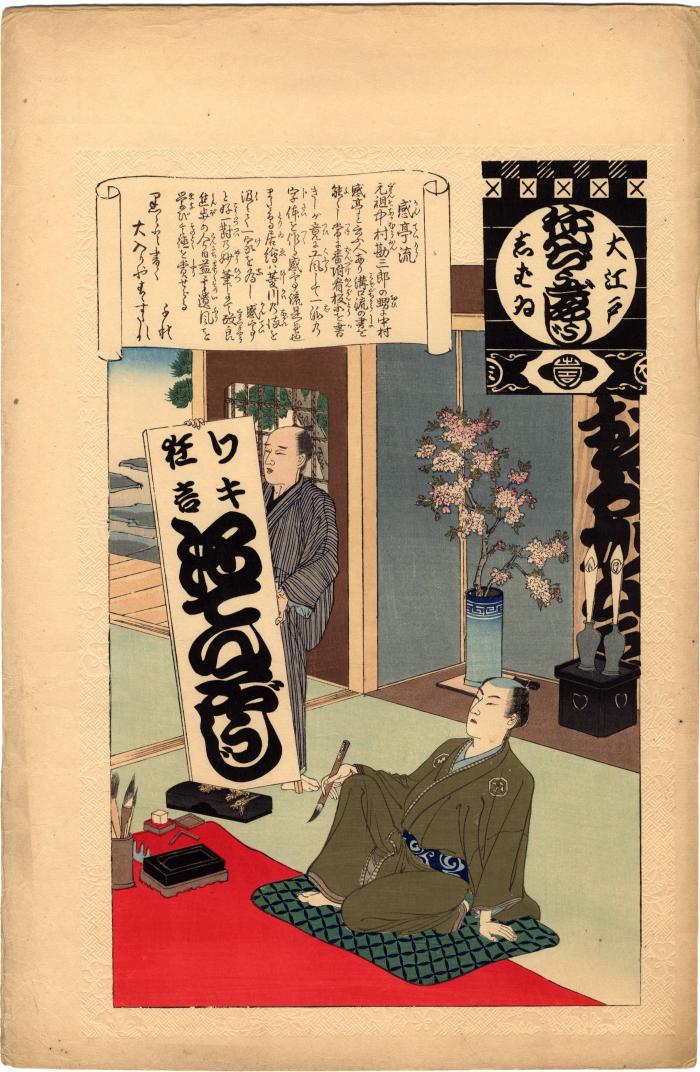Adachi Ginkō (安達吟光) (artist 1853 – 1902)
The Sign Painter (Kanteiryū - 感亭流) from the Annual Events of the Edo Theatre (Ō-Edo shibai nenjū-gyōji - 大江戸しばゐねんぢうぎやうじ)
08/1897
11.375 in x 17.375 in (Overall dimensions) Japanese woodblock print
British Museum
Museum of Fine Arts, Boston
Waseda University
Ritsumeikan University
Edo-Tokyo Museum
National Diet Library
Tokyo Metropolitan Library - from the same edition as this one in the Lyon Collection
Tokyo Metropolitan Library - from the edition with all of the publishing information in the lower left
Marega Collection at the Library of Università Pontificia Salesiana (via Ritsumeikan University) The text reads: 「ワキ狂言 酒てんどうし」「元祖中村勘三郎の甥に中村感亭と云ふ人あり 溝口流の書を能くし常に番附看板等を書きしが竟に工夫して一派の字体を作る 感亭流是れ也 また鳥居絵は菱川の流を汲みて一家を為し感亭と好一対の妙筆にて改良進歩の今日益其遺風を学び其徳を賞せらる 千秋」「黒々と書く大入りや春すたれ」
The original publisher of this print was Hasegawa Sumi (長谷川壽美). This series was co-designed with Torii Kiyosada. The first edition appears to have all of the pertinent publishing information listed in the lower left out side of the image itself. Some sources say this print appeared as early as 04/1897, while other sources say it was 07/1897.
****
According to the Kodansha Encyclopedia of Japan (vol. 4, 1983 edition, p. 153) the Kantei style of calligraphy originated in 1779 (An-ei 8 or 安永8年) with Okazakiya Kanroku (岡崎屋勘六 or おかざきや.かんろく)an employee of the Nakamuraza (中村座 or なかむらざ). "Its thick, curved strokes form compact characters with few open areas between them, suggesting a 'full house,' and it quickly won favor in the theatrical world. Easily recognized at a distance...[it is still used today]." It is also used to announce the rankings of sumo wrestlers - although Leiter notes that their is a slight difference in style.
Leiter in his New Kabuki Encyclopedia (1997 edition, p. 281) provides additional information. "Minami Okazakiya Kanroku (1746-1805), a teacher of his family's calligraphy, who lived in Edo's Sakai-chō [堺町 or さかいちょう], created the style when he did the ōnodai kamban...signing his work 'Kantei.'" Originally the Kantei style was used exclusively on kanban (看板 or かんばん) or billboards used to announce theatrical productions, but later were used for programs and scripts.
****
The border areas surrounding the image are deeply and elaborately embossed.
Meiji era (明治時代: 1868-1912) (genre)
Historical - Social - Ephemera (author)
